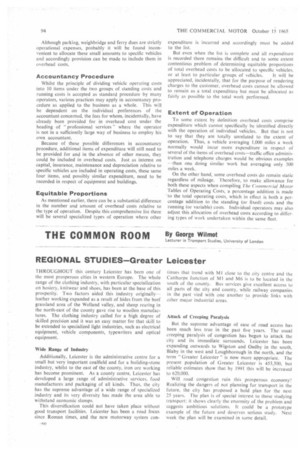THE COMMON ROOM
Page 96

If you've noticed an error in this article please click here to report it so we can fix it.
By George Wilmot
Lecturer in Transport Studies, University of London
REGIONAL STUDIES Greater Leicester
THROUGHOUT this century Leicester has been one of the most prosperous cities in western Europe. The whole range of the clothing industry, with particular specialization on hosiery, knitwear and shoes, has been at the base of this prosperity. Two factors aided this industry originally-leather working expanded as a result of hides from the beef grassland area of the Welland valley, and sheep rearing in the north-east of the county gave rise to woollen manufactures. The clothing industry called for a high degree of skilled precision and it was an easy matter for that skill to be extended to specialized light industries, such as electrical equipment, vehicle components, typewriters and optical equipment.
Wide Range of Industry Additionally, Leicester is the administrative centre for a small but very important coalfield and for a building-stone industry, whilst to the east of the county, iron ore working has become prominent. As a county centre, Leicester has developed a large range of administrative services, food manufactures and packaging of all kinds. Thus, the city has the supreme advantage of a wide range of specialized industry and its very diversity has made the area able to withstand economic slumps.
This diversification could not have taken place without good transport facilities. Leicester has been a road focus since Roman times, and the new motorway system con finites that trend with M1 close to the city centre and the Catthorpe Junction of Ml and M6 is to be located in the south of the county. Bus services give excellent access to all parts of the city and county, while railway companies in the past vied with one another to provide links with other major industrial areas.
Attack of Creeping Paralysis But the supreme advantage of ease of road access has been much less true in the past five years. The usual creeping paralysis of congestion has begun to attack the city and its immediate surrounds. Leicester has been expanding outwards to Wigston and Oadby in the south. Blaby in the west and Loughborough in the north, and the term " Greater Leicester" is now more appropriate. The present population of Greater Leicester is 453.500, but reliable estimates show that by 1991 this will be increased to 620,000.
Will road congestion ruin this prosperous economy? Realizing the dangers of not planning for transport in the future, the city has proposed a bold plan for the next 25 years. The plan is of special interest to those studying transport: it shows clearly the enormity of the problem and suggests ambitious solutions. It could be a prototype example of the future and deserves serious study. Next week the plan will be examined in some detail.








































































































































